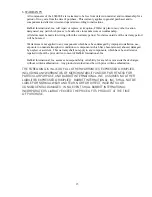
C. Installing the Receiver
The receiver is a printed circuit board measuring 3”x6”. It is mounted in a plastic
snap track that is provided with each unit.
The snap track can be mounted in existing control panels or enclosures may be
ordered from the factory.
1) Attach the snap track to the panel back pan or other surface using 2 small screws or a suitable adhesive.
2) Snap the LS8000/2/R receiver card into the snap track.
3) Connect shielded cable to the 3 terminals marked GND, SIG, V+. (See page for wiring diagram.)
4) Connect the proper supply voltage and relay output wiring for your application. (See page ___.)
NOTE:
All wiring must conform to the National Electric Code or other enforcing authorities that
apply in your area.
D. Typical Applications and Wiring Diagrams Follow
1. LS8000/2 Terminal Layout
Page 4
2.
Receiver
Card
Page
5
3.
Ladder
Diagrams
Page
6-9
4. CALIBRATION
There are two methods of using the LS8000/2 RECEIVER, with one probe or with
two probes. If your application uses a single probe with 2 setpoints follow
instructions “A” through “D”.
If your application uses 2 separate probes in the same tank for “Auto Fill” or “Auto
Empty”, use steps A, B and E.
If your application uses 2 separate probes in 2 different tanks and you are not using
the latching relay, use steps A and E.
PLEASE READ THE ENTIRE CALIBRATION PROCEDURE BEFORE CALIBRATING THE
LS8000/2
.
There are 4 adjustments required to set the LS8000/2:
A) Set switches 1 and 2 for “FSH” or “FSL”
B) Set switches “POR” and “LATCH”
C) Calibrate the low setpoint
D) Calibrate the high setpoint
E) 2 probe calibration
A. Set Switches 1 and 2 for “FSH” or “FSL”
The fail safe feature provides a “false alarm” in case of power outage or major component failure. When
properly selected, the fail safe feature can protect equipment or alert you of a unit failure.
1. Fail Safe High (FSH) means that the relay is energized when NO PRODUCT is touching the probe. The
green LED indicates relay status and is on when the relay is energized. When product comes into contact
with the probe, the relay is de-energized.
2. Fail Safe Low (FSL) means that the relay is energized when PRODUCT IS touching the probe.
NOTE:
Due to the wide variety of applications and possible control or alarm functions, the
proper fail safe selection will depend on your circumstances, please call your distributor or the
factory if you need assistance.
Switch 1 selects FSH or FSL for setpoint 1 relay. Switch 2 selects this function for setpoint 2 relay. Simply
toggle the dip switch toward the FSH or FSL marking on the LS8000/2 receiver card.
B. Setting “POR” and “LATCH” Dip Switches
Switches “POR” and “LATCH” are 2 of the 4 dip switches on the LS8000/2 sensing card.
“LATCH” selects automatic fill or automatic empty.
“AUTOMATIC FILL” is when the latching relay energizes below the low setpoint and de-energizes at the high
setpoint.
“AUTOMATIC EMPTY” is when the latching relay energizes at the high setpoint and de-energizes below the
low setpoint.
The green LED indicates relay status. The green LED is on when the relay is energized.
When “LATCH” is UP, “AUTOMATIC FILL” is selected.
When “LATCH” is DOWN< “AUTOMATIC EMPTY” is selected.
12



































